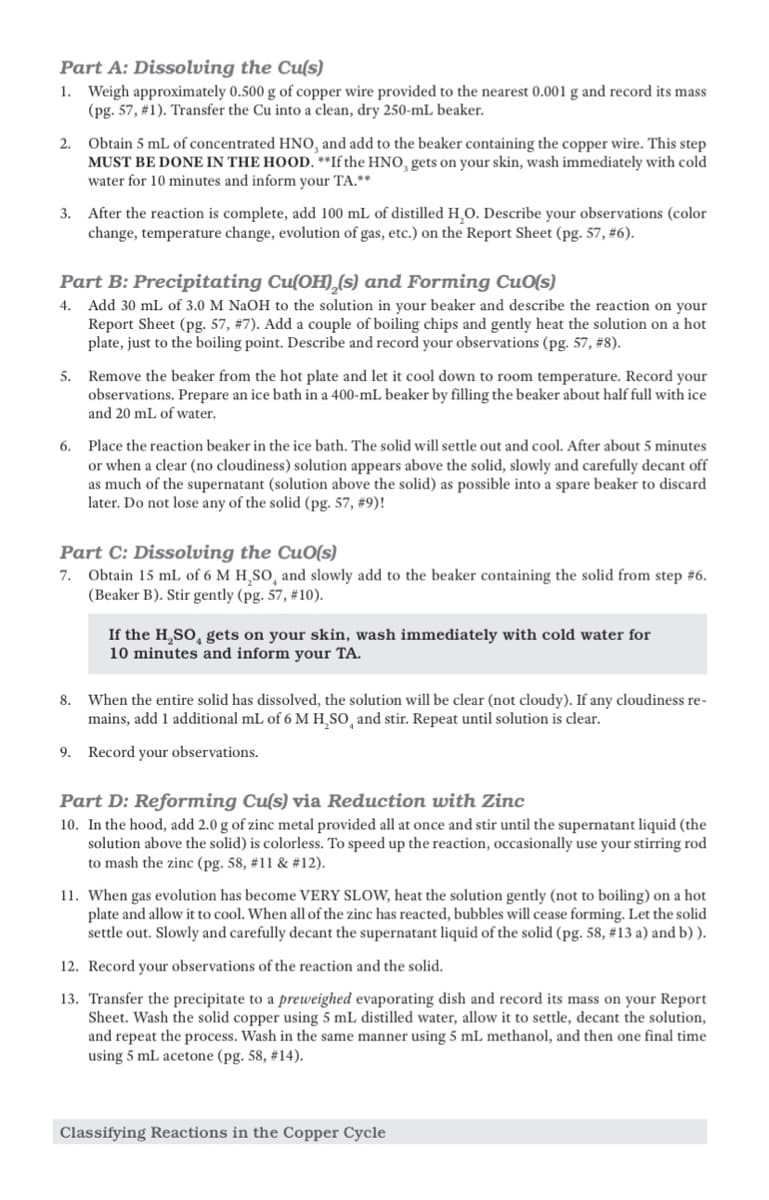Chemistry
10th Edition
ISBN:9781305957404
Author:Steven S. Zumdahl, Susan A. Zumdahl, Donald J. DeCoste
Publisher:Steven S. Zumdahl, Susan A. Zumdahl, Donald J. DeCoste
Chapter1: Chemical Foundations
Section: Chapter Questions
Problem 1RQ: Define and explain the differences between the following terms. a. law and theory b. theory and...
Related questions
Question
Give a specific example from this experiment of an error that would lead to a percent yield greater than 100%. Explain the effect.

Transcribed Image Text:14. Prepare a steam bath (Figure 6.1) and place the evaporating dish over the bath to dry the solid.
Once dry, remove the boiling chips from the evaporating dish, dry off the bottom, and weigh the
evaporating dish plus copper. Records its mass. Calculate the final mass of copper.
power
StirreriHot Plate
hot top
Calculate the percent yield of the copper.
Figure 6.1.
Calculations
What is the theoretical yield of the copper solid, Cu?
Precipitate
-Evaporating dish
-Boiling chips
CHayden McNeil, LLC
-Steam bath
Classifying Reactions in the Copper Cycle
Experi
6
55

Transcribed Image Text:Part A: Dissolving the Cu(s)
1. Weigh approximately 0.500 g of copper wire provided to the nearest 0.001 g and record its mass
(pg. 57, #1). Transfer the Cu into a clean, dry 250-ml beaker.
2. Obtain 5 mL of concentrated HNO, and add to the beaker containing the copper wire. This step
MUST BE DONE IN THE HOOD. **If the HNO, gets on your skin, wash immediately with cold
water for 10 minutes and inform your TA.**
3. After the reaction is complete, add 100 mL of distilled H₂O. Describe your observations (color
change, temperature change, evolution of gas, etc.) on the Report Sheet (pg. 57, #6).
Part B: Precipitating Cu(OH),(s) and Forming Cuo(s)
4. Add 30 mL of 3.0 M NaOH to the solution in your beaker and describe the reaction on your
Report Sheet (pg. 57, # 7). Add a couple of boiling chips and gently heat the solution on a hot
plate, just to the boiling point. Describe and record your observations (pg. 57, #8).
5. Remove the beaker from the hot plate and let it cool down to room temperature. Record your
observations. Prepare an ice bath in a 400-mL beaker by filling the beaker about half full with ice
and 20 mL of water.
6. Place the reaction beaker in the ice bath. The solid will settle out and cool. After about 5 minutes
or when a clear (no cloudiness) solution appears above the solid, slowly and carefully decant off
as much of the supernatant (solution above the solid) as possible into a spare beaker to discard
later. Do not lose any of the solid (pg. 57, #9)!
Part C: Dissolving the CuO(s)
7. Obtain 15 mL of 6 M H₂SO, and slowly add to the beaker containing the solid from step #6.
(Beaker B). Stir gently (pg. 57, #10).
If the H₂SO, gets on your skin, wash immediately with cold water for
10 minutes and inform your TA.
8. When the entire solid has dissolved, the solution will be clear (not cloudy). If any cloudiness re-
mains, add 1 additional mL of 6 M H₂SO, and stir. Repeat until solution is clear.
9. Record your observations.
Part D: Reforming Cu(s) via Reduction with Zinc
10. In the hood, add 2.0 g of zinc metal provided all at once and stir until the supernatant liquid (the
solution above the solid) is colorless. To speed up the reaction, occasionally use your stirring rod
to mash the zinc (pg. 58, #11 & #12).
11. When gas evolution has become VERY SLOW, heat the solution gently (not to boiling) on a hot
plate and allow it to cool. When all of the zinc has reacted, bubbles will cease forming. Let the solid
settle out. Slowly and carefully decant the supernatant liquid of the solid (pg. 58, #13 a) and b)).
12. Record your observations of the reaction and the solid.
13. Transfer the precipitate to a preweighed evaporating dish and record its mass on your Report
Sheet. Wash the solid copper using 5 mL distilled water, allow it to settle, decant the solution,
and repeat the process. Wash in the same manner using 5 mL methanol, and then one final time
using 5 mL acetone (pg. 58, #14).
Classifying Reactions in the Copper Cycle
Expert Solution
This question has been solved!
Explore an expertly crafted, step-by-step solution for a thorough understanding of key concepts.
This is a popular solution!
Trending now
This is a popular solution!
Step by step
Solved in 2 steps

Knowledge Booster
Learn more about
Need a deep-dive on the concept behind this application? Look no further. Learn more about this topic, chemistry and related others by exploring similar questions and additional content below.Recommended textbooks for you

Chemistry
Chemistry
ISBN:
9781305957404
Author:
Steven S. Zumdahl, Susan A. Zumdahl, Donald J. DeCoste
Publisher:
Cengage Learning

Chemistry
Chemistry
ISBN:
9781259911156
Author:
Raymond Chang Dr., Jason Overby Professor
Publisher:
McGraw-Hill Education

Principles of Instrumental Analysis
Chemistry
ISBN:
9781305577213
Author:
Douglas A. Skoog, F. James Holler, Stanley R. Crouch
Publisher:
Cengage Learning

Chemistry
Chemistry
ISBN:
9781305957404
Author:
Steven S. Zumdahl, Susan A. Zumdahl, Donald J. DeCoste
Publisher:
Cengage Learning

Chemistry
Chemistry
ISBN:
9781259911156
Author:
Raymond Chang Dr., Jason Overby Professor
Publisher:
McGraw-Hill Education

Principles of Instrumental Analysis
Chemistry
ISBN:
9781305577213
Author:
Douglas A. Skoog, F. James Holler, Stanley R. Crouch
Publisher:
Cengage Learning

Organic Chemistry
Chemistry
ISBN:
9780078021558
Author:
Janice Gorzynski Smith Dr.
Publisher:
McGraw-Hill Education

Chemistry: Principles and Reactions
Chemistry
ISBN:
9781305079373
Author:
William L. Masterton, Cecile N. Hurley
Publisher:
Cengage Learning

Elementary Principles of Chemical Processes, Bind…
Chemistry
ISBN:
9781118431221
Author:
Richard M. Felder, Ronald W. Rousseau, Lisa G. Bullard
Publisher:
WILEY